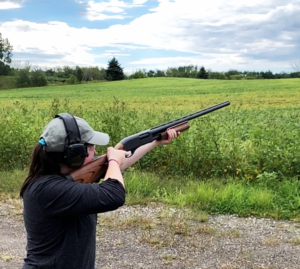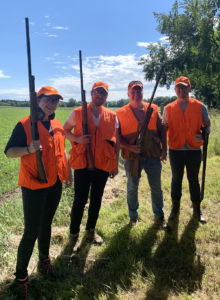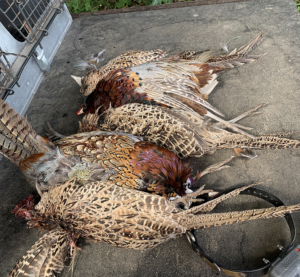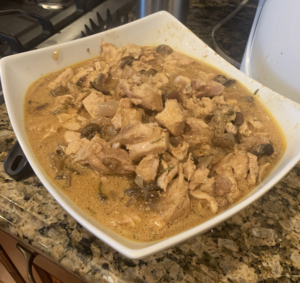Taking a Look at the Carnivore in the Mirror
Trigger warning: Hunting practices and animal death

I could feel the rubbery, nimble necks of the dead pheasants underneath my fingertips as I carried them to the sink to be plucked and gutted. My grip on their bodies was loose, making it easy to drop them quickly. I wanted to drop them, but I resisted. If I was going to take an animal’s life, I could at least manage to hold its carcass in my hands for a few moments.
My stomach turned as we cut a small hole in each of the pheasant’s stomachs and used the puncture to rip the skin and feathers from their lower abdomen to chest. Instantly, a pungent smell filled my nostrils. It wasn’t the smell of death, yet. It smelled like purgatory, the fine line between living and dying, between fresh and rot. Their small bodies were still warm, a reminder of just how thin that line can be.
* * *
For as long as I can remember, I’ve been a meat eater. Born and (partially) raised in Kansas, the daughter of a farmer who raised cattle, consuming pieces of dead animals for my meals was routine. I even continued to eat meat when I worked at a vegan fast food restaurant in Boulder, Colorado during my senior year of high school. I really appreciated the restaurant’s mission to serve healthy food and take care of the planet. But, while I embraced the plant-based lifestyle, I didn’t feel the need to go completely vegan.
I am a meat eater, but that doesn’t mean I don’t love animals. I’ve got two dogs and grew up raising all kinds of rodents, from chinchillas to guinea pigs. In elementary school, I was the kid who rallied the teacher for more classroom pets and would spend hours of my day studying their habits and tendencies.
I am a meat eater, but I understand the problems with our food supply in this country and how factory farming is intensifying climate change. I’ve watched numerous documentaries and read many articles about feedlots and battery cages. These issues weigh heavily on me, and I try to stay cognizant of where my food comes from, supporting local farms with ethical and sustainable practices whenever possible. There’s more I should do. There’s more I want to do, but I still eat meat. The practice has been ingrained in my history and diet for so long that I try to find practical ways to keep it in my life.
Still, I’ve grown aware of how disconnected I am from my food, how easy it is to add meat to any meal anywhere in this country. Oftentimes, the meat isn’t even identifiable as the animal it once was. It’s been stripped of its characteristics and stuffed into a taco or sandwich for our satiation. We have no idea what the animal went through to be on our plate – where it came from, how it lived, how it was killed. And some of us don’t care to know.
In my early twenties, I remember one of my friends being disgusted by rotisserie chicken. She didn’t want to look at the bird’s body, a reminder that what we were eating used to be living. I, on the other hand, loved it. I appreciated having to pick out the bones and tendons to get to the meat. The work feels important, appropriate. I wanted to learn more about it. I started to feel like it was my responsibility as a meat eater to understand what it meant to kill an animal, to rip it apart and use its innards as nutrients. And, since feedlots don’t exactly offer volunteer shifts, I thought the best method for me to do that was hunting.
* * *
The act of hunting is older than we are. Just in 2013, archeologists found evidence of animal bones and stone tools used by ancient hominins that show our ancestors were killing animals more than 2 million years ago.
Several Native American tribes have had many sacred traditions around hunting for thousands of years. Before a hunt, the Cherokee matriarchal nation took part in a sacred ritual. Once they killed the animal, some tribes thanked it for sacrificing itself by smearing blood on their cheeks or drinking the blood of their first kill. When the animal is brought back to the home, they show it respect by using every part of it.
Hunting looks a lot different today than it did 2 million years ago. In 2016, 101.6 million Americans participated in wildlife-related activities like hunting, fishing and wild-life watching, spending nearly $156 billion, according to the U.S. Department of Interior.
Even though so many participate in hunting, the sport isn’t exactly a casual endeavor. I couldn’t just approach some girlfriends and suggest we spend the day looking for and ultimately killing animals. We would need guns, equipment, proper clothes. So my hunting goals sat on the back burner for years. That is, until I expressed interest to my future father-in-law, Brian. He’d started shooting with a couple of his sons about 10 years ago as a way to spend time together. He enjoyed the sport, getting to be with his sons outdoors for an adventure. Brian enjoyed seeking out all kinds of adventure. When we’ve visited them in Minnesota, we’ve thrown axes, practiced our swings at Topgolf (a putting range, complete with a restaurant and bar), solved our way through an escape room, played whirly ball (a game on bumper cars that mixes basketball and lacrosse) and even gone hydroflying (a sport where one straps themselves to a board in a lake and gets launched high into the air by water pressure). On one trip, I brought up my hunting ambitions to Brian.
“Do you think I could maybe go hunting with you guys some time?” I said.
He was surprised by my request, but overly enthusiastic at my interest. I explained my reasoning, that I thought it was an important experience for me to have and, frankly, that it looked like fun.
“Next time you’re in Minnesota, I’ll set it up for us,” he said.
In early September, when hunting season began, my fiancé Matt and I drove with our dogs to Minnesota. The weather was hot for the time of year, in the mid-90s and, in typical Minnesota fashion, very humid. Eager for the latest adventure, Brian scheduled an afternoon pheasant hunt with a guide at a farm. I knew little about pheasants, except that one could hunt them, but I certainly hadn’t seen pheasant meat available for purchase at the Whole Foods 365 in our neighborhood where we lived in Los Angeles, or on the menu at any of the hip, farm-to-table-style restaurants in the city. Still, I was eager to learn.
We spent the morning reviewing gun safety. Our hunting group consisted of Brian, Matt, Matt’s brother Ben and I. The three guys had years of experience handling guns, but I’d only gone shooting a handful of times, aiming at targets at shooting ranges or out on a farm. After reviewing all of the safety guidelines, we practiced aiming by shooting clay pigeons – small, circular discs that are launched into the air by a small machine. After about 40 tries, aiming and shooting at the discs in midair, I finally hit one. It was clear that shooting a live animal wasn’t going to be easy.
We arrived at the farm midday and met our hunting guide Rod, a polite, mid-sized man in his seventies. He brought his three Brittany dogs with him. Bred for hunting, Brittanys act as pointers for their human comrades. A pointer goes in front of the hunters and tries to sniff out the pheasants, which are typically resting on tree branches or in thick grass. Once they see their prey, they stop and, aptly, point it out. Rod had a device attached to each dog’s collar to track their movements. If a dog was still for more than five seconds, the device would start beeping, letting us know it may be focused on a pheasant.

We put on bright orange hats and hunting vests and stuffed our pockets with bullets. We carried Remington Model 870 pump-action shotguns, each weighing around seven pounds, as we weaved through the various fields of tall grass and corn stalks around the farm. Immediately, I broke out in a sweat. Bugs started biting my exposed skin. The gun felt heavy as I aimed the barrel straight to the sky for safety. Instantly, I loved hunting. Being out in nature, getting a workout— I could see why so many Americans participated, with or without animals.
After about ten minutes of traipsing up and down the fields, Rod’s beeper went off. One of the dogs was pointing at a pheasant. Rod directed the dog to get closer and flush it out. The four of us came in close, getting our guns ready. The bird flew into the air, its feathers rich colors of reds and oranges. Before I could even get my gun safety off, Ben, Matt and Brian had all shot off their first round. The bird hit the ground just as quickly as it had flown up, and the dog who had spotted it went to retrieve it, all before I’d fully registered that we had just killed an animal.
The afternoon continued on like that for several hours, us hunters walking up and down the fields, the dogs finding the birds and either Ben, Matt or Brian shooting them down. I had a few opportunities, but I hesitated too long, my inexperience with a firearm clearly on display. Still, I enjoyed the experience and spending time with the guys.
We’d been out in the fields for several hours, and had shot six or seven pheasants when my energy started to lag. My biceps and shoulders were sore from carrying the gun and my legs were getting weak pushing through the thick terrain. It seemed like my fellow hunters were slowing down as well. I hadn’t shot a pheasant, but I told myself that was okay. I’d learned so much and been a part of the adventure. Plus, I could still help gut the birds and cook them. I didn’t need to shoot one for the afternoon to be worth my time.
Just when I was ready to call it quits, we neared the end of a corn field and one of the dogs darted behind Matt and me. Rod’s beeper went off.
“There it is, there it is,” he said.
Before I could even blink, a beautiful rooster pheasant took flight 15 feet in front of us. My rifle was in position, I switched off the safety, hesitated for a millisecond, then pulled the trigger. The bird hit the ground. Cheers from my hunting comrades filled the air. Watching the pheasant fall made me feel useful, like I’d accomplished something. I also felt a moment of sadness for the pheasant, which was important. I’ve eaten so many animals over the years, but never had to watch any of them die. Now I was seeing, and participating, in the act. It was right in front of me, and I couldn’t ignore it. Rod placed the pheasant in the back pocket of his hunting vest with the others. There was no ceremony. I didn’t drink the bird’s blood or smear it on my face, but I did whisper a “thank you” to the beautiful animal.

* * *
Pheasants — and a lot of wild game — have a reputation for not tasting particularly great. Maybe that’s part of the reason we don’t see them on the menu at restaurants or in the grocery store. But I’ve learned it can be tasty. It’s all in the preparation.
My future mother-in-law, Ann, and I researched the best recipes and ways to cook the pheasant meat the next morning. Ann didn’t like to go hunting, but she was always up for cooking the game her boys brought home. She’d prepared pheasant before so she had some idea of what we should do to make the lean meat taste good. We decided on a creamy sauce, mixed with spices and vegetables in a crockpot for six to seven hours. We carefully cut the meat off of the bones, saving them to make a pheasant broth the next day.

We poured our pheasant soup concoction over wild rice and served it that evening. As we sat down for the meal, I quietly said one more thank you to the pheasants who had lost their lives to feed ours. A circle of life was on display at the dinner table. The sustenance we were having we had worked for. We knew where it came from. We knew what it had been. We understood every part of it.
* * *
A couple of months after my hunting experience, I am still a carnivore. Killing and gutting an animal may turn some off of meat and motivate them to try an entirely plant-based diet. For me, the experience enhanced my appreciation. It taught me what goes into taking an animal’s life, and it’s motivating me to be even more intentional about the food I eat.
Hunting is not for everyone. Eating meat is not for everyone. But taking time to push ourselves outside of our comfort zones, to learn about different ways to do things and to put intention behind our actions can lead us to better respect our earth, its creatures and each other. I still have much more work to do in this area, but I’m thankful to that beautiful pheasant for teaching me that no animal’s life should be taken for granted.
Barbara Platts is an award-winning columnist and the online editor for Sweet Jane Magazine. She’s worked in many forms of journalism, from public radio to newspaper, and is thrilled to be pursuing her MFA for nonfiction writing at Antioch University. She works for Lunch Ticket on the interview, blog, and creative nonfiction teams. She lives in Los Angeles with her fiancé and two adorable pups. Follow her on Twitter and Instagram @BarbaraPlatts.





